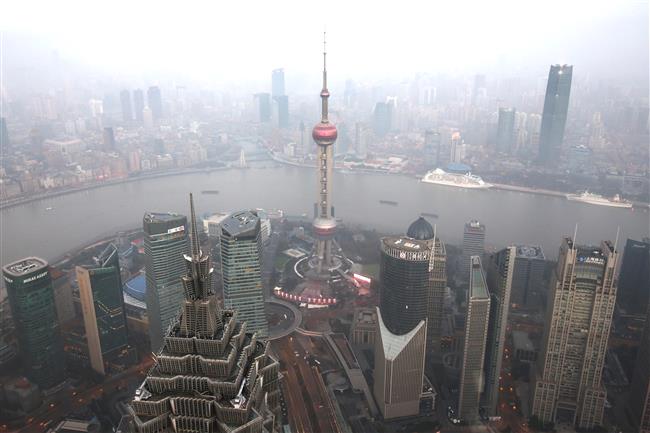City sets eyes on reducing PM2.5 pollutant to improve air quality
Shanghai will lower the average density of the hazardous PM2.5 pollutant particles by a bigger margin than had been expected.
The average density of PM2.5 — Shanghai’s major air pollutant — will fall “steadily below 40 micrograms per cubic meter” by 2020 as envisioned in the draft of a new three-year (2018-2020) environmental protection plan issued yesterday. Previously, the target was expected to be set at 42 micrograms per cubic meter.
The draft plan is Shanghai’s seventh three-year environmental protection project, which also sets targets for the city’s water quality, sewage dealing capacity, industrial waste discharge control and other environmental issues.
According to the plan, Shanghai will eradicate heavily polluted days (with a daily average Air Quality Index higher than 200) by 2020. The city reported two days of heavy pollution in 2017 — July 24 and December 31 — with PM2.5 and ozone being the major pollutants respectively.
“We planned for a stricter target as Shanghai’s air quality witnessed promising improvement over the past few years,” Bai Guoqiang, director of Shanghai Environmental Protection Bureau’s Comprehensive Planning Division, told Shanghai Daily.
“The target might still be adjusted, and even be made stricter as the draft would be revised after we collect opinions from the city government, from the Shanghai People’s Congress, and from other walks of the society.”
The city’s yearly environment report for 2017 is yet to be released. According to the 2016 report, the average density of PM2.5 was 45 micrograms per cubic meter, a 15.1 percent drop from 2015.
Excellent or good air quality (with AQI no higher than 100) had been reported in 276, or 75.4 percent of the days in 2016. The new three-year plan raised the target for 2020 to 80 percent.
World Health Organization’s recommended standard for PM2.5 within a 24-hour period of time is no greater than 25 micrograms per cubic meter, and 10 micrograms per cubic meter over a one-year period. The nation’s daily limit is 75 and the yearly limit 35.
To meet the new target for air quality, Shanghai will cut the city’s coal consumption by a further 5 percent by 2020. Over 150,000 green energy cars will be promoted around the city in the next three years.

The average density of PM2.5 shall be below 40 micrograms per cubic meter by 2020 as the city will mobilize itself for clean air.
National standard
Control of volatile organic compounds emission will be applied to industries like automobile and furniture making, shipbuilding, printing, and electronic parts manufacturing.
By 2020, over 95 percent of the water samples collected from the city’s water quality supervision spots will meet the lowest national standard, says the plan. Currently, about 78 percent is meeting the standard. Furthermore, 600 kilometers of waterways around the city will be cleaned in the next three years.
To enhance the city’s sewage dealing capacity, a batch of sewage plants will be constructed or renovated in Qingpu, Jiading districts and the Pudong New Area. Sludge dealing facilities will also be constructed.
Apart from air and water quality, the new three-year plan also put the spotlight on problems like soil pollution, household garbage and ecological environment, said Bai. A formal plan is expected to be released before April.
A batch of wet refuse dealing plants will be built in Pudong, as well as Songjiang and Minhang districts. The city’s household garbage dealing capacity will be raised to 3.28 tons per day by 2020.
To improve the city’s ecological environment, 1.2 million square meters of vertical planting, 60 boulevards and over 12,600 hectares of forests and ecological corridors will be built in the next three years.
The draft has been posted on Shanghai Environmental Protection Bureau’s official Weibo account. Those who have suggestions can e-mail sepc2018@163.com or fax 021-63556038 before Friday.















